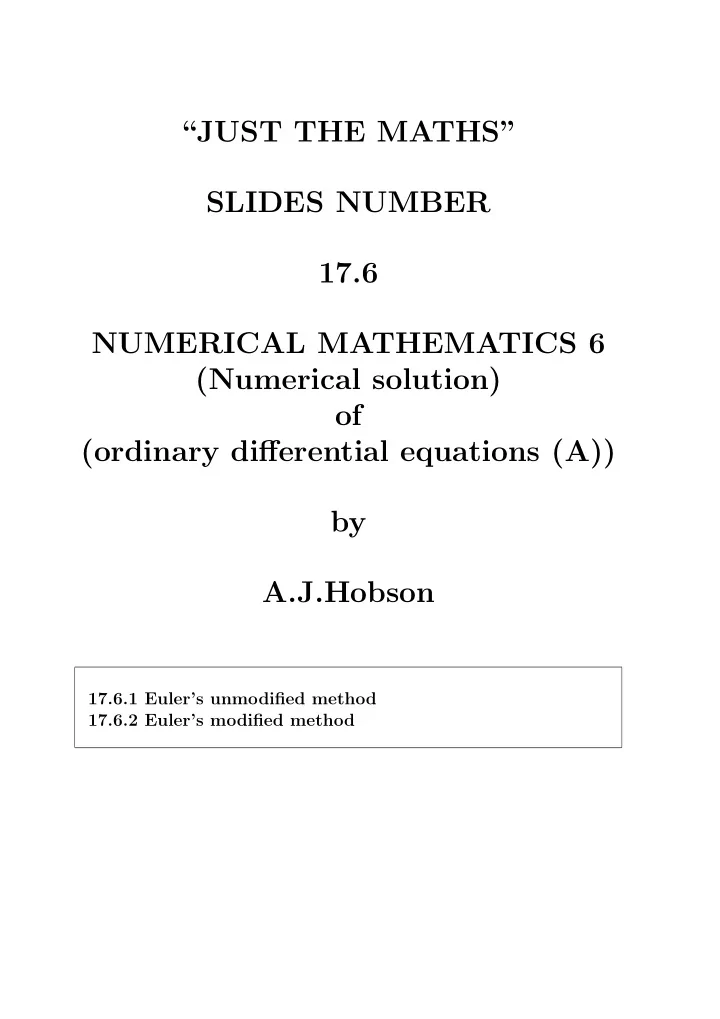

“JUST THE MATHS” SLIDES NUMBER 17.6 NUMERICAL MATHEMATICS 6 (Numerical solution) of (ordinary differential equations (A)) by A.J.Hobson 17.6.1 Euler’s unmodified method 17.6.2 Euler’s modified method
UNIT 17.6 NUMERICAL MATHEMATICS 6 NUMERICAL SOLUTION OF ORDINARY DIFFERENTIAL EQUATIONS (A) 17.6.1 EULER’S UNMODIFIED METHOD Every first order ordinary differential equation can be written in the form d y d x = f ( x, y ) . If y = y 0 when x = x 0 , then the solution for y in terms of x represents some curve through the point P 0 ( x 0 , y 0 ). Suppose we need y at x = d , where d > x 0 . Sub-divide the interval from x = x 0 to x = d into n equal parts of width δx . 1
y ✻ P 0 y n ✲ y 0 x O x 0 d Let x 1 , x 2 , x 3 , ... be the points of subdivision. x 1 = x 0 + δx, x 2 = x 0 + 2 δx, x 3 = x 0 + 3 δx, ..., ..., d = x n = x 0 + nδx. If y 1 , y 2 , y 3 , ... are the y co-ordinates of x 1 , x 2 , x 3 , ... , we must find y n . 2
The increase in y , when x increases by δx ≃ d y d x δx . Since d y d x = f ( x, y ), y 1 = y 0 + f ( x 0 , y 0 ) δx, y 2 = y 1 + f ( x 1 , y 1 ) δx, y 3 = y 2 + f ( x 2 , y 2 ) δx, ..., ..., y n = y n − 1 + f ( x n − 1 , y n − 1 ) δx. Each stage uses the previously calculated y value. Note: The method will be the same if d < x 0 except that δx will be negative. In general, y i +1 = y i + f ( x i , y i ) δx. 3
EXAMPLE Use Euler’s method with 5 sub-intervals to continue to x = 0 . 5 the solution of the differential equation, d y d x = xy, given that y = 1 when x = 0; (that is, y (0) = 1). i x i f ( x i , y i ) y i +1 = y i + f ( x i , y i ) δx y i 0 0 1 0 1 1 0.1 1 0.1 1.01 2 0.2 1.01 0.202 1.0302 3 0.3 1.0302 0.30906 1.061106 4 0.4 1.061106 0.4244424 1.1035524 5 0.5 1.1035524 - - Accuracy Here, we may compare the exact result with the approx- imation by Eulers’ method. � d y � x d x. y = ln y = x 2 2 + C. x 2 2 . y = Ae 4
At x = 0, y = 1 and, hence, A = 1. x 2 2 . y = e But a table of values of x against y reveals the following: x 2 x e 2 0 1 0.1 1.00501 0.2 1.0202 0.3 1.04603 0.4 1.08329 0.5 1.13315 There is an error in our approximate value of 0.0296, which is about 2.6%. Attempts to determine y for values of x which are greater than 0.5 would result in a very rapid growth of error. 5
17.6.2 EULER’S MODIFIED METHOD In the previous method, we used the gradient at P 0 in order to find P 1 , and so on up to P n . But the approximation is better if we use the average of the two gradients at P 0 and P 1 . y ✻ P 1 ✧✧✧✧ ✥ ✥✥✥✥ P 0 ✲ x O x 0 x 1 The gradient, m 0 at P 0 is given by m 0 = f ( x 0 , y 0 ) . The gradient, m 1 at P 1 is given approximately by m 1 = f ( x 0 + δx, y 0 + δy 0 ) , where δy 0 = f ( x 0 , y 0 ) δx . The average gradient between P 0 and P 1 is given by 0 = 1 m ∗ 2( m 0 + m 1 ) . 6
The modified approximation to y at the point P 1 is given by y 1 = y 0 + m ∗ 0 δx. Similarly, we proceed from y 1 to y 2 and so on until we reach y n . In general, y i +1 = y i + m ∗ i δx. 7
EXAMPLE Use Euler’s modified method with 5 sub-intervals to con- tinue to x = 0 . 5 the solution to the differential equation, d y d x = xy, given that y = 1 when x = 0; (that is, y (0) = 1). m i = δy i = i x i y i f ( x i , y i ) f ( x i , y i ) δx 0 0 1 0 0 1 0.1 1.005 0.1005 0.0101 2 0.2 1.0202 0.2040 0.0204 3 0.3 1.0460 0.3138 0.0314 4 0.4 1.0832 0.4333 0.0433 5 0.5 1.1330 —— —— i m i +1 = m ∗ i = y i +1 = 1 f ( x i + δx, y i + δy i 2 ( m i + m i +1 ) y i + m ∗ i δx 0 0.1 0.05 1.005 1 0.2030 0.1518 1.0202 2 0.3122 0.2581 1.0460 3 0.4310 0.3724 1.0832 4 0.5633 0.4983 1.1330 5 —— —— —— 8
Recommend
More recommend